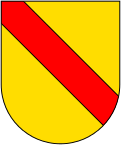Categories Online-Shop Germany German States until 1871 Baden
Baden

The founder of the dynasty of Baden margraves was Hermann I (1052-1074), the elder son of duke Berthold of Carinthia (1024-1078). His son Hermann II in 1112 called himself for the first time Margrave of Baden. And that although Baden was never a margravate; the title comes from the dukes of Zähringen, who were related to the Baden house and ruled the margravate of Verona. They simply transferred their title to the new area. From 1535 to 1771 the rule was divided into the Protestant line Baden-Durlach and into the Catholic line Baden-Baden. 1771 inherited Charles Frederik of Baden-Durlach the possessions of the extinct Baden-Baden line, whereby the two margravates were reunited.
Before the 14th Century, the Baden region was supplied mainly by the surrounding mints such as Speyer, Worms and Würzburg with pennies. In 1362 margrave Rudolf VI was confirmed by the Roman-German king Charles IV in his mint law, even if it was never officially awarded. Now pennies were also struck here. Under the margraves Jakob I (1431-1453) and Charles I (1453-1475) finally the "Pfennigzeit" ended, as the Baden monetary policy was again determined by foreign influences (such as Strasbourg and Milan Groschen). The local coinage experienced a renewed upswing with the Heimsheim contract of 1501 and the mint in Baden-Baden produced a large amount of shillings, hellers and gold guilders. From the division of the country, the thalers and its parts dominate the monetary affairs.


